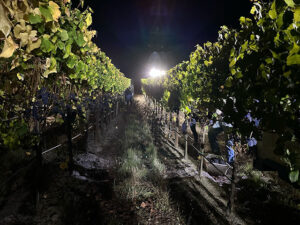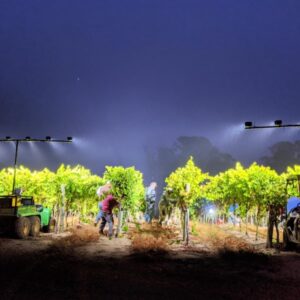
Harvest preparation in winegrape production begins long before the machines or picking crews pull into the vineyard.
Carefully monitoring the maturation of different winegrape varieties in different climates, irrigating to meet plant needs and scouting for insect pests and diseases take place throughout the growing season. Crop managers note different winegrape varieties and changing environmental conditions are major factors in fruit maturity and harvest timing.
Microclimates and soils can drastically impact the rate of fruit ripening and at what level when ready for harvest, Riggs Lokka, vineyard manager for Emeritus Vineyards in Sebastopol, said. Hot daytime temperatures and whether there is significant cooling in the evenings affect the fruit maturation process. In addition, soil type can have an impact. Lokka said winegrapes planted on heavier soils tend to ripen earlier than those in sandy soils.

Craig Ledbetter with Vino Farms in the Lodi area said in early July he expected the heat wave being experienced across California winegrape growing areas would influence the berry maturation process and harvest timing. Berry color changes (signs of veraison) were beginning to appear in some winegrape varieties in early July, which means harvest there is 35 to 45 days out. Berry maturity slows during a heat wave as leaves shut down at high temperatures, and insect pests could also play a part in maturity as mite infestations can damage leaves, slowing the ripening process. He estimated the earliest varieties in the Lodi area would be ready for harvest five to seven days ahead of the normal harvest timing.
Paso Robles experienced very hot temperatures during early July, but some of those locations also cool off at night. Carter Collins, general manager of Viticulture Management Inc. in Paso Robles, said the nighttime cooling allows vines to recover from the heat. Looking at the average start time for harvest with the earliest varieties, he said the vineyards are ahead of last year, which was on the late side but still behind 2022’s early start.
“Mother Nature drives when the harvest begins, but canopy management and crop load play a part,” Collins said. In the Paso Robles winegrape growing area, in preparation for harvest, leafing is done before the end of June, and before veraison begins.

Preparation Considerations
Harvest preparation begins with canopy management. Lokka said once bloom is complete, his crews will begin leafing vines. Depending on location, they have two methods: dappled light and full removal from the morning side based on the trellising system. Dappled light is leaving guard leaves and removing the leaves surrounding the clusters inside the vines. Full-on removal from the morning side involves removing all leaves six inches above the cordon arm on the morning side only. Once leafing is complete, he said crop estimation and bunch thinning can begin.
Lokka said at Emeritus, they also scout vineyards for Botrytis and mildew throughout the growing season. There is a spray routine in preventing disease outbreaks, and problem areas receive immediate attention, he noted.
In the Lodi area, Ledbetter said actual harvest prep begins with shoot thinning, leaf removal and suckering, common practices leading up to harvest depending on the grape variety. He noted early leaf removal is done in the Lodi area to acclimate the berries to sunlight, reducing the chances of sunburn on ripening fruit.
Last year’s cooler June temperatures did not help acclimate the berries to hotter July temperatures, he said, and more sunburn occurred when hotter temperatures arrived later in the season.
Water management is an important consideration leading up to harvest, Ledbetter said. Irrigation strategies prior to harvest differ among many varieties. Some winegrape varieties are slightly water stressed until veraison, then given full ET. Water is cut 10 to 14 days leading up to expected harvest date. Other winegrape varieties produce larger berries that will split skins if overwatered between veraison and harvest. Once split, the berries are prone to rot. These varieties are deficit irrigated throughout the entire season.
Collins said just enough irrigation is done to “keep the vines happy” and not stressed.
Emeritus vineyards are dry farmed.
Testing for sugar levels or brix in the fruit begins in early to mid-August for Collins. Depending on the variety and the brix/acidity levels desired for winemaking, the testing will determine when harvest begins. Vineyards in the Paso Robles region have diverse growing conditions, and the cooling and heating make a difference in fruit maturity. Testing begins with the earlier varieties depending on the location. Once testing begins, he said he will test twice a week to gauge the maturity progress.
Depending on how vineyard floors are managed, when a harvest date is determined for a variety, there can be mowing or tillage to clear out weeds. Canes with leaves may also be trimmed to lessen the amount of leaves that end up in the harvest loads. In Lodi, Ledbetter said final sprays will be completed in late June or July, noting that area is one of the first to begin harvesting winegrapes.

Nearly all Lodi-area winegrape vineyards are harvested mechanically, Ledbetter said. Worker shortages continue to drive the mechanical harvest choice. While most of the Paso Robles-area vineyards are machine-harvested, Collins said about 20% to 25% of the acres are hand-harvested. Hand-harvest crews work at night, he said, and lighting and other safety measures must be in place. Emeritus’ pinot noir grapes are all hand-harvested, also during the night.
In addition to watching readiness of the fruit for harvest, Collins said all the harvest equipment needs to be ready.
“We inspect harvest machinery and make sure all are in good working order; we don’t want breakdowns just when we need to be moving,” Collins said.
“I believe each vineyard has a way of expressing readiness for harvest, and each manager has a practical method to harvest a quality crop,” Lokka said.











